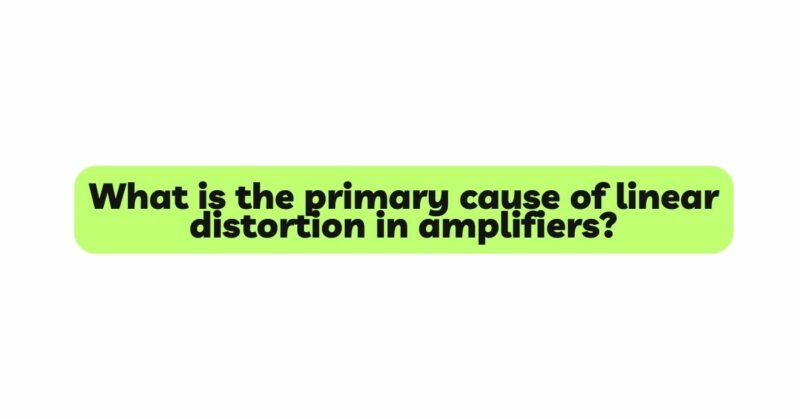In the realm of audio engineering and musical fidelity, the pursuit of sonic purity is a constant endeavor. Linear amplifiers are designed to faithfully reproduce the input signal without introducing coloration or alterations. However, the presence of linear distortion can mar this aspiration, leading to subtle yet perceptible changes in the sound. In this comprehensive exploration, we will delve into the intricate world of linear distortion in amplifiers, focusing on its primary cause, its impact on audio quality, and strategies to mitigate its effects for a more transparent and pristine audio experience.
Understanding Linear Distortion
Linear distortion, in contrast to harmonic or nonlinear distortion, is a phenomenon that emerges when an amplifier fails to replicate the input signal accurately, thereby introducing subtle deviations that alter the original waveform.
Types of Linear Distortion:
- Amplitude Distortion: Involves variations in amplitude across different frequencies, often referred to as frequency response anomalies.
- Phase Distortion: Leads to a shift in the phase relationship between different frequencies, causing signal misalignment.
- Group Delay Distortion: Occurs when different frequency components of the signal experience different delays, affecting the overall transient response.
Primary Cause of Linear Distortion in Amplifiers
The core cause of linear distortion in amplifiers can be attributed to the inherent limitations of electronic components and their complex interactions.
1. Nonlinearities in Components: Electronic components, despite their design for linearity, inherently exhibit nonlinear behavior under certain conditions. This can include variations in capacitance, resistance, and inductance that lead to deviations from the ideal response.
2. Complex Component Interactions: Amplifiers consist of intricate circuitry involving numerous components. The interactions between these components, particularly in high-frequency ranges, can result in unintended distortions.
3. Impedance Mismatch: Impedance mismatches between various stages of the amplifier can lead to reflections and interactions that introduce phase and amplitude distortions.
4. Frequency Dependency: Different components exhibit variations in their behavior across frequency ranges. Capacitors, for example, may show different behaviors at high and low frequencies, contributing to frequency-dependent distortions.
Impact of Linear Distortion on Audio Quality
While linear distortion may not be as overt as harmonic distortion, its impact on audio quality is subtle yet significant, affecting the overall transparency and accuracy of the sound.
1. Altered Timbre and Tone: Linear distortion can lead to coloration in the sound, altering the tonal characteristics and timbre of the audio source.
2. Reduced Clarity and Detail: Amplifiers affected by linear distortion may compromise the reproduction of fine details in the audio signal, leading to a loss of clarity and resolution.
3. Impaired Imaging and Soundstage: Distorted amplification can hinder the accurate placement of instruments and voices in the stereo image, impacting the spatial perception of the soundstage.
4. Transient Response Degradation: Linear distortion can affect the transient response of the amplifier, blurring the attack and decay of notes and diminishing the dynamics of the music.
Minimizing Linear Distortion: Strategies and Techniques
While it may be challenging to eliminate linear distortion entirely, employing specific strategies can significantly mitigate its effects and enhance audio fidelity.
1. Component Selection and Matching: Opt for high-quality components with stringent tolerances. Careful matching of components, such as transistors, minimizes variations that contribute to distortion.
2. Circuit Design and Layout: Implement intelligent circuit designs that reduce component interactions and impedance mismatches. A well-organized circuit layout minimizes unwanted signal reflections.
3. Negative Feedback Loops: Incorporating negative feedback loops helps correct discrepancies between the input and output signals, effectively reducing linear distortion.
4. Careful Component Placement: Position components thoughtfully within the circuit layout to minimize signal path lengths and reduce interactions between components.
5. Advanced Feedback Techniques: Implement advanced feedback techniques, such as global feedback and local feedback, to achieve more precise control over linear distortion reduction.
6. Differential Amplification: Utilize balanced or differential amplifier configurations to reject common-mode distortions and enhance the overall linearity of the system.
7. Test and Measurement Equipment: Employ high-precision test and measurement equipment to identify and quantify linear distortions, enabling accurate adjustments and optimizations.
Conclusion
The primary cause of linear distortion in amplifiers emerges from the intricate interactions and inherent limitations of electronic components. Understanding this cause allows engineers, audiophiles, and musicians to tackle the challenge of minimizing distortion and preserving audio fidelity. While complete eradication may be elusive, the strategies and techniques discussed empower individuals to significantly reduce the impact of linear distortion on sound quality. Through meticulous component selection, intelligent circuit design, and a commitment to precision, the pursuit of audio excellence remains within reach, allowing for a more accurate, transparent, and captivating listening experience.


